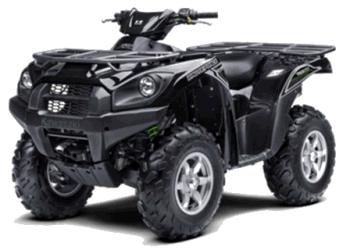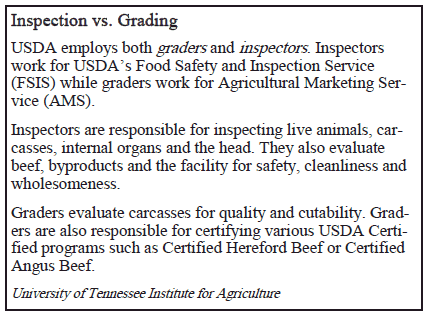

To send a message to an author, click on the author's name at the end of the article.
This Month in Ag Connection | Ag Connection - Other Issues Online
As the temperatures continue to climb, one might be finding themselves wanting to enjoy the outdoors by riding an ATV (All-Terrain Vehicle) around the farm. All-Terrain vehicles are becoming increasingly popular on farms because of their utility. They can be used to haul livestock feed or transportation to the field. As they have increased in popularity on farms, accidents and injuries to youth and adults have increased. This coincidence reveals the importance of riders understanding all the ATVs safety precautions.

It is important to realize ATVs come in different sizes and one must fit the ATV to the rider's size. For adults, there are sport and utility ATVs, and for younger riders there are three different categories. The youth categories are designed for smaller hands and feet, and travel at slower speeds appropriate for their age. Every ATV manufactured by members of the ATV Safety Institute (atvsafety.org) will have a warning label, clearly stating the minimum age of the rider. This label is affixed so it can easily be read by the rider when seated in the proper operating position.
Even if the rider is older than 16, he/she may not have the skills, strength, or maturity to operate that size of an ATV, making it important that you assess your situation individually to ensure you get the proper size for the rider.
All ATV riders need to have the maturity to understand what safety equipment should be worn. The first priority for all riders should be to wear a properly fitted ATV helmet. There are helmets on the market that are made specifically for ATV riders because they have the proper amount of face protection and have the ability to absorb energy on impact. Bicycling, skateboarding, and rollerblading helmets are not acceptable safety equipment for ATV riders. In addition to having a helmet, the rider should wear some form of eye protection. The eye protection may be attached to the helmet or may need to be purchased separately. If it is not attached, an ANSI-approved pair of goggles with hard-coated polycarbonate lenses should be purchased. Other safety equipment to be worn includes gloves, boots, long pants, and a long sleeved shirt.
Not all safety precautions associated with ATVs are associated with equipment. For instance, all riders should understand and accept the fact that it is not safe to carry a passenger. All-Terrain vehicles are equipped with a single seat and when carrying a passenger, it prevents the driver from being able to shift their weight correctly when making turns. Additionally, there is nothing on the ATV for the passenger to hold onto to prevent them from being thrown off the ATV. Even if the ATV has a double seat it is still not recommended to ride with a passenger.
No ATV should ever be operated on a paved surface such as a public road because of the safety of non-ATV riders traveling the road. Additionally, ATVs are not designed to travel on paved roads and can be hard to control when on pavement. Likewise, going over jumps, climbing or going down steep inclines, driving through high water, and making sharp turns at high speeds are all maneuvers that are unsafe on ATVs and increase the likelihood of getting injured. Whether or not all ATV riders understand and follow the above suggestions, it is still a good idea for all riders to be supervised because both youth and adults can fall victim to an ATV accident. It is recommended all riders complete an ATV rider course.
Source: Kent Shannon, Ag Engineer
This Month in Ag Connection | Ag Connection - Other Issues Online
The terminology of quality grade and yield grade are often used interchangeably to describe cattle, but the terms differentiate the two carcass traits. Beef producers, and those thinking of entering value-added beef enterprises, need to recognize the difference and how each is utilized in the cattle industry. Knowledge of how quality and yield grades are applied may increase profitability.
Yield grades equate to an estimate of the percent retail yield of the four primal cuts of beef including the chuck, rib, loin and round. The following traits are used to determine yield grade:
There are five USDA yield grades from 1 to 5. A yield grade of 1 offers the largest amount of beef, whereas a yield grade of 5 offers the least. Through yield grades, individual animal value is determined and thus profitability is impacted. Producers can utilize these USDA yield grades to market their cattle.

Purchasers of beef tend to be more familiar with quality grade as it relates to palatability (eating experience) of meat. Included in this is flavor, juiciness and tenderness. This is expressed through eight quality grades.

These grades impact prices at both the producer and consumer level. Typically, beef that grades prime, choice and select are utilized in retail and restaurants. Lower grades of beef are most commonly used in further processed products, such as canned soups and frozen meals. Quality grade is determined by marbling (intramuscular fat) and maturity (physiological age).
Producers who understand yield and quality grades are better equipped to make decisions about genetics, nutrition, health and production practices, as well as product marketing.
Source: Jason C. Morris, Ag Business Specialist
This Month in Ag Connection | Ag Connection - Other Issues Online
As summer temperatures rise, cattle producers should watch for signs of heat stress in their herds. Cattle cannot dissipate heat very effectively compared to other animals, and so are more susceptible to heat stress. They rely primarily on respiration to cool themselves because they do not sweat efficiently. While on pasture, cattle will seek shade to cool themselves. When cattle are in closely confined areas such as trucks, holding pens, and feedlots, or areas without shade access, they are more likely to become stressed.
Heat stress can occur any time the temperature-humidity index is above 80, or if night time temperatures consistently remain above 70 degrees. Early warning signs include restlessness and decreased feed intake. If stress continues, respiration increases and cattle will begin to pant and slobber. Long term effects include decreased weight gain and reduced fertility. Producers should watch for signs of heat stress and be prepared to intervene if necessary.
While the summertime heat is unavoidable, the following measures can be used to lessen the impact in the herd.
Source: Jenna Monnig, Livestock Specialist
This Month in Ag Connection | Ag Connection - Other Issues Online
This Month in Ag Connection | Ag Connection - Other Issues Online
Ornamentals
Vegetables
Fruit
Turf
Pests
Source: Missouri Botanical Garden
This Month in Ag Connection | Ag Connection - Other Issues Online
Aug. 3 - Greenley Research Center Field Day - Novelty, MO
Sept. 14 - Forage Systems Rearch Center Field Day - Linneus, MO
Oct. 2 - Missouri Chestnut Roast - New Franklin, MO
For more information https://cafnr.missouri.edu/calendar/

Publishing Information
Ag Connection is published monthly for Northeast and Central areas of Missouri producers and is supported by the University of Missouri Extension, the Missouri Agricultural Experiment Station, and the MU College of Agriculture, Food and Natural Resources. Managing Editor: Mary Sobba.